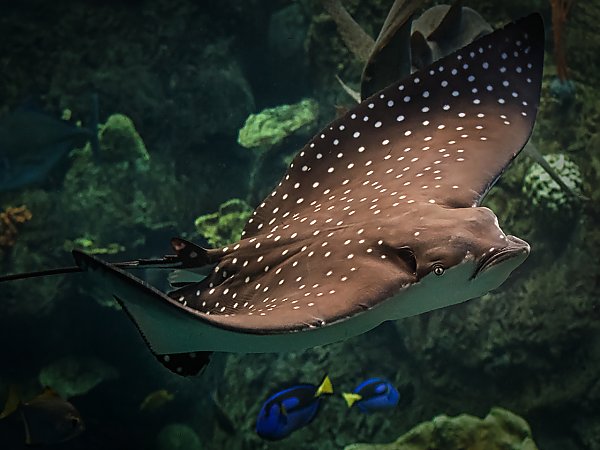Whitespotted Eagle Ray
Aetobatus ocellatus
Eagle rays are cartilaginous fish that are found in tropical oceans. They have white spots on their dark backs and seem to “fly” through the water. This large ray can reach up to 9 ft (2.7m) across and 440 lbs (200kg)! Their flat teeth are used to crush open shells and mollusks.

Credit: Robin Riggs

SPECIES IN DETAIL
Whitespotted Eagle Ray
Aetobatus ocellatus
CONSERVATION STATUS:
CLIMATE CHANGE: Not Applicable
At the Aquarium
Tropical Pacific Exhibit
Geographic Distribution
The whitespotted eagle ray is found in the tropical Indo-West Pacific.
Habitat
Bays, coral reefs, and the open ocean in the Tropical Pacific.
Physical Characteristics
The whitespotted eagle ray has smooth skin and a venomous barb at the base of their long tail. They are a large ray reaching up to 9ft (2.7m) across. They have a dark back with white spots speckling their body. These rays have long pointed fins that allow them to “fly” through the water. Their tail is long and whip-like, reaching 2.5-3 times their body length. Their flat teeth are useful for crushing open shells and mollusks, which make up a large portion of their diet.
Size
Size: (up to) 9ft (2.7m) across, Average is about 6 ft (1.8m) across, Length: 4 to 6.5 feet long (1.2-2m) not counting their tail. Weight: (up to) 440lbs (200kg)
Diet
Crustaceans, worms, snails, octopuses, and small fish.
Reproduction
Eagle rays are ovoviviparous, meaning the eggs develop inside the mother and hatch inside of her. A litter usually has less than four pups, each being around 18 cm to at least 50 cm (0.5-1.6ft) in size at birth. Gestation is about 12 months.
Behavior
These gentle giants look as if they’re flying underwater by moving their large fins up and down. They will use their venomous barb at the base of their long tail to defend themselves.
Adaptation
Eagle rays have flat teeth that can crush open their prey such as shellfish. The location of their mouth is also well-adapted for eating benthic (bottom dwelling) animals like shellfish and crustaceans.
Longevity
25 years
Conservation
The whitespotted eagle ray is listed as vulnerable on the IUCN Red List. Some of their natural range occurs in protected areas. This species is also sometimes trapped in gillnets used for coastal fishing. Pollution, especially in estuaries where these rays may be found, can also negatively impact them.
The Aquarium is participating in this ray’s AZA species survival plan to help build knowledge of the rays’ genetic diversity.
Special Notes
They can weigh up to 440 lbs!
Their flat teeth are designed to crush open hard shelled items like clams!
SPECIES IN DETAIL | Print full entry
Whitespotted Eagle Ray
Aetobatus ocellatus
CONSERVATION STATUS:
CLIMATE CHANGE: Not Applicable
Tropical Pacific Exhibit
The whitespotted eagle ray is found in the tropical Indo-West Pacific.
Bays, coral reefs, and the open ocean in the Tropical Pacific.
The whitespotted eagle ray has smooth skin and a venomous barb at the base of their long tail. They are a large ray reaching up to 9ft (2.7m) across. They have a dark back with white spots speckling their body. These rays have long pointed fins that allow them to “fly” through the water. Their tail is long and whip-like, reaching 2.5-3 times their body length. Their flat teeth are useful for crushing open shells and mollusks, which make up a large portion of their diet.
Size: (up to) 9ft (2.7m) across, Average is about 6 ft (1.8m) across, Length: 4 to 6.5 feet long (1.2-2m) not counting their tail. Weight: (up to) 440lbs (200kg)
Crustaceans, worms, snails, octopuses, and small fish.
Eagle rays are ovoviviparous, meaning the eggs develop inside the mother and hatch inside of her. A litter usually has less than four pups, each being around 18 cm to at least 50 cm (0.5-1.6ft) in size at birth. Gestation is about 12 months.
These gentle giants look as if they’re flying underwater by moving their large fins up and down. They will use their venomous barb at the base of their long tail to defend themselves.
Eagle rays have flat teeth that can crush open their prey such as shellfish. The location of their mouth is also well-adapted for eating benthic (bottom dwelling) animals like shellfish and crustaceans.
25 years
The whitespotted eagle ray is listed as vulnerable on the IUCN Red List. Some of their natural range occurs in protected areas. This species is also sometimes trapped in gillnets used for coastal fishing. Pollution, especially in estuaries where these rays may be found, can also negatively impact them.
The Aquarium is participating in this ray’s AZA species survival plan to help build knowledge of the rays’ genetic diversity.
They can weigh up to 440 lbs!
Their flat teeth are designed to crush open hard shelled items like clams!

